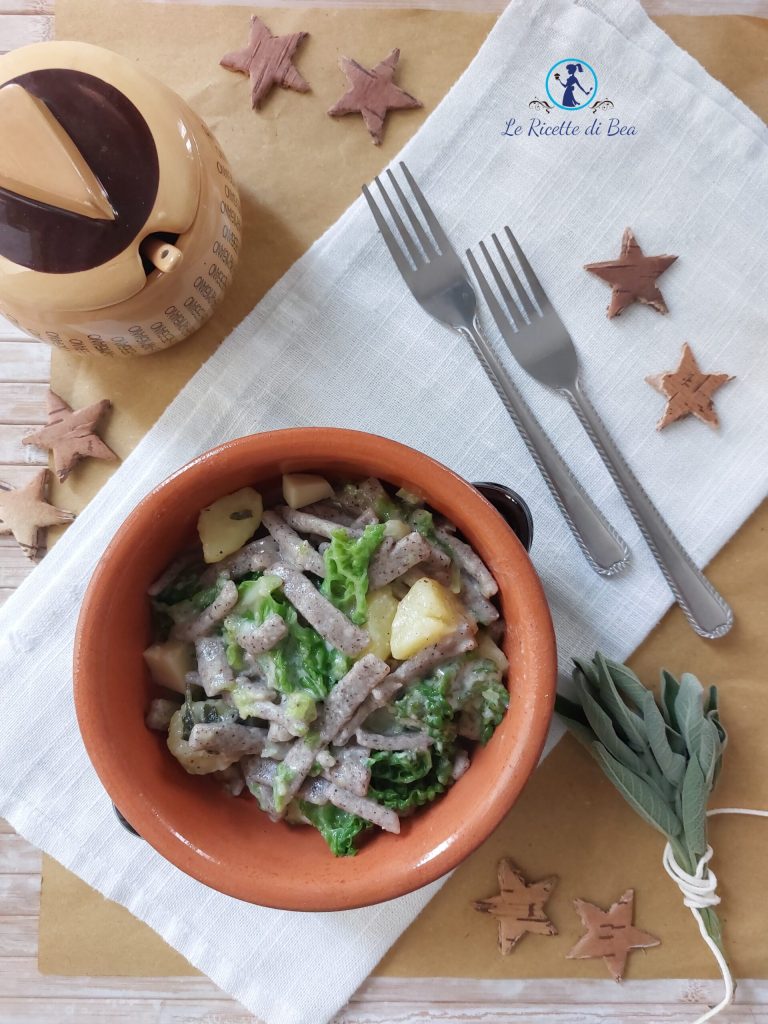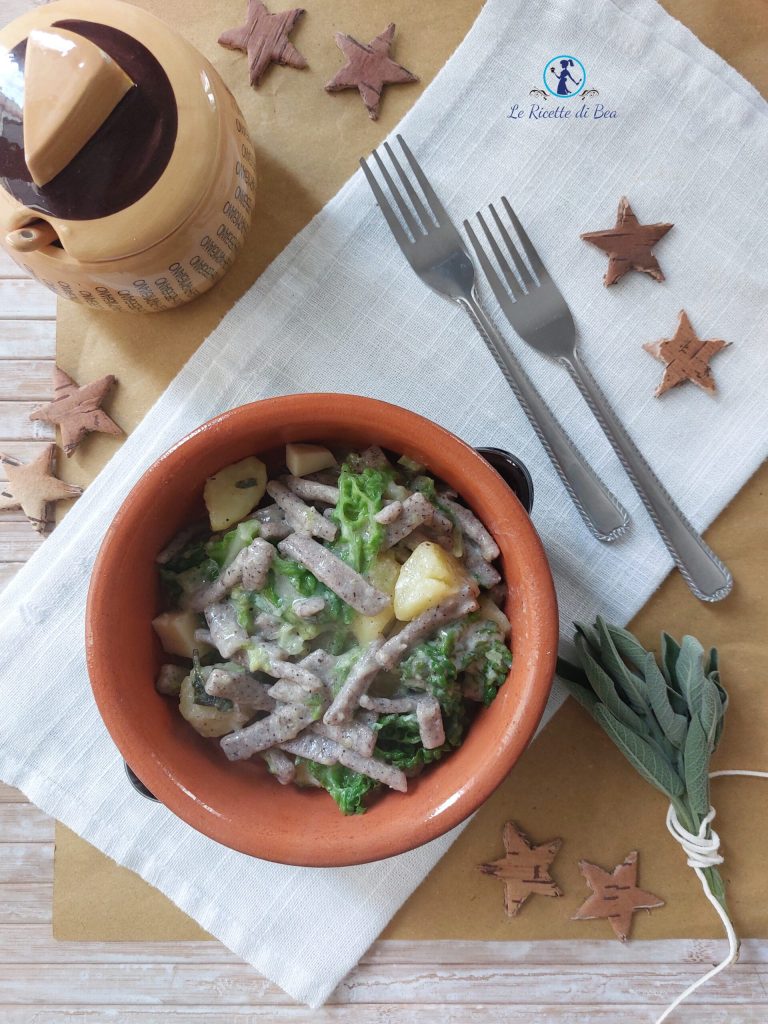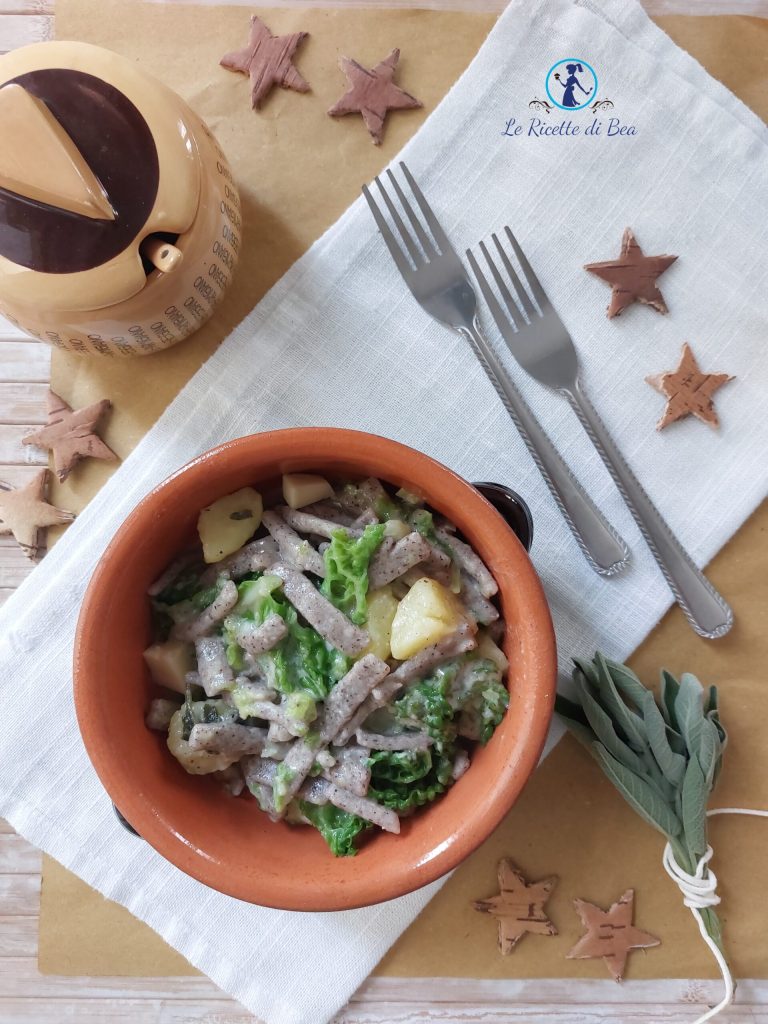Have you ever heard of Pizzoccheri? Because today we will prepare the Pizzoccheri, a typical dish from the heart of Valtellina! Today I’m taking you on a journey with me through the mountains of Valtellina, a dive into the culinary tradition of this area of Italy, among family recipes handed down from mother to daughter, a flavor journey that will captivate you!
It might be because Christmas is approaching, it might be because my friend and colleague Samantha gave me a pack of buckwheat flour from Valtellina a few months ago, it might be because I couldn’t wait to prepare and especially try this new dish! Would you believe me if I told you I hadn’t even tasted them before making them with Sami?
Discovering new recipes thanks to work colleagues is one of the things I love the most. I thank Samantha for preparing this recipe from Valtellina with me. With few and simple instructions, following her advice, I made homemade fresh pasta for the first time! I didn’t think I was capable of it, so many steps or at least I always thought so.
Making fresh pasta with buckwheat flour and water was easier than I thought, perhaps and almost certainly, thanks to Samantha, her guidance, and those steps she showed me as the preparation progressed. Sami didn’t feel like appearing in the step-by-step video recipe, but if you look closely in the video, you can see hands different from mine, more decisive movements than mine, she really put her effort into showing me and all of you what to do!
We already shared another moment together in my kitchen. About a year ago, we made pretzels, and from there came the desire for Pizzoccheri from Valtellina, a typical winter dish from her home. Since she has been living here, in Marche, she often makes them to continue this culinary tradition. Then unfortunately some time passed, some shifts didn’t match, or other commitments of both of us, but we often talked about this first course with buckwheat flour, cabbage, potatoes, and lots of cheese.
A few weeks ago, the opportunity almost created itself. I was off work, and she finished her shift quite early in the morning. We bought all the ingredients—we work together in a hypermarket, so it wasn’t too difficult—and we arranged to meet in my kitchen to prepare the Pizzoccheri from Valtellina and record the video recipe that you can find below. I hope you like them and especially that you want to prepare this Valtellina dish with us!
Below I leave you other recipes that you can prepare using buckwheat flour. I have indeed proposed Twisted Cookies, Homemade Multigrain Bread, and one of my favorite cakes, the Buckwheat Cake with Raspberry Jam. Three easy recipes, delicious, and with that unmistakable aroma that buckwheat flour has and will give to your preparations!
Every link below is clickable and will take you directly to the recipe you choose to read. I also remind you that I wait for you every morning in the group and on the Facebook fan page with the Recipe of the Day! An unmissable appointment to start the day together!

- Difficulty: Easy
- Cost: Economical
- Rest time: 20 Minutes
- Preparation time: 20 Minutes
- Portions: 4People
- Cooking methods: Stovetop
- Cuisine: Italian
- Seasonality: Fall, Winter, Christmas
- Energy 837.62 (Kcal)
- Carbohydrates 113.56 (g) of which sugars 6.01 (g)
- Proteins 26.59 (g)
- Fat 35.08 (g) of which saturated 20.65 (g)of which unsaturated 12.89 (g)
- Fibers 17.98 (g)
- Sodium 557.50 (mg)
Indicative values for a portion of 275 g processed in an automated way starting from the nutritional information available on the CREA* and FoodData Central** databases. It is not food and / or nutritional advice.
* CREATES Food and Nutrition Research Center: https://www.crea.gov.it/alimenti-e-nutrizione https://www.alimentinutrizione.it ** U.S. Department of Agriculture, Agricultural Research Service. FoodData Central, 2019. https://fdc.nal.usda.gov
Ingredients for four servings of Valtellina Pizzoccheri
- 12.35 oz buckwheat flour
- 10.58 oz flour (About 7 oz for the dough while the rest will be used for working)
- 1 cup water (at room temperature)
- 1 pinch coarse salt (to cook the Valtellina Pizzoccheri)
- 1 tsp extra virgin olive oil (to cook the Pizzoccheri)
- 7.05 oz savoy cabbage
- 4 potatoes (medium-small)
- 3.52 oz cheese (Casera DOP is preferred, but if you can't find it, you could use Fontina as we did)
- 1.76 oz Grana Padano DOP
- 1 clove garlic
- 3.52 oz butter
- 4 leaves sage
- 1 pinch black pepper
Please note that this amount is indicated for four people, or for four generous plates of homemade Valtellina Pizzoccheri. However, I feel compelled to tell you and also to emphasize that it all depends on how much you usually eat. I can tell you that as good as they are, they are heavy as a meal, I used all the ingredients listed above but then cooked and dressed only two servings of Valtellina pizzoccheri. This is because for us they were abundant, we don’t eat much at home, we are all on a diet for one reason or another, so I then followed Samantha and her mom’s advice and froze the raw pizzoccheri. I will write to you how to store them in the part below the recipe labeled as storage and tips.
The quantities were weighed before starting the preparation of the homemade Pizzoccheri but Samantha would like to point out that sometimes a few more grams of flour or water is necessary. This is because you should always keep in mind that flour doesn’t always have the same consistency, room temperature and water temperature can slightly vary the amounts. Also note that she makes this homemade fresh pasta by eye, so we tried to be as precise as possible with the quantities.
Here below you’ll find the total weight of the recipe and the weight per single portion if you serve four portions. Keep in mind that in my opinion, with these quantities, you can satisfy, and without problems, six people. Last consideration to make is that this is a first course that also contains vegetables, greens, butter and cheeses. So it’s very complete, and if you’re still hungry, you could proceed with a good second course, maybe some grilled meat!
Tools for Valtellina Pizzoccheri Recipe
- 1 Bowl
- 1 Measuring Cup
- 1 Scale
- 1 Wooden Spoon
- 1 Skillet
- 1 Pot
- 1 Pastry Board
- 1 Silicone Rolling Pin
- 1 Knife
- 1 Cutting Board
- 1 Potato Peeler
- 1 Colander
- 1 Dishcloth
Steps for Valtellina Pizzoccheri Recipe
Let’s start by taking all the utensils we will use for the preparation of this fresh pasta dish and placing them on the work surface. Then take all the necessary ingredients for the pizzoccheri, weigh them, and arrange them on the surface. Also, place a pot large enough and with high sides on the stove after filling it with water, and add coarse salt.
Pour the two flours into a bowl with nice high sides, take the measuring cup with the room-temperature water, and start pouring it slowly, stirring the flours with your hand as you go. Set aside the white flour because we will need it during the course of the recipe.
Perform this step while already leaning on the wooden pastry board, because soon we will move on to working the fresh pasta on the board. Quickly combine the flours so as to understand if there is a need for more water or more flour, in this case, use only the white flour. We used classic all-purpose flour for the preparation of the Valtellina pizzoccheri.
Flour the board and turn over the dough, work the fresh pasta until it feels nice and compact, create a ball, and cover it with a dishcloth. The Tip from Samantha: it shouldn’t be too soft, otherwise the pizzoccheri will break during cooking.
If you can’t incorporate all the flour, you can add small amounts of water during the work on the wooden board so that there are no small lumps of dough left on the pastry board. Do it like this: create a small hole in the center of the ball of flours, add a small amount of water, I took it with the tip of my fingers from a small bowl, gather the pieces of dough on the wooden board and place them in the hole along with the water. Work with your hands, and you’ll see they will be incorporated easily. This step is very well shown in the video recipe you find below the first photo, as Samantha explains it to me, so that it can be clearer to you this trick.

Let’s move on to preparing the Valtellina Pizzoccheri Sauce. As anticipated, we placed a pot with water on the stove to bring it to a boil. Peel the potatoes, cut them into not too small cubes. Shred the cabbage with a knife after washing and patting it dry. Pour a drizzle of extra virgin olive oil into the water, this will help prevent the pizzoccheri from sticking together during cooking with the other ingredients. Then add the potatoes to the pot and let cook for about 15 minutes.
Meanwhile, grate the Grana Padano cheese or other aged cheese that you have chosen. Then cut into cubes the Casera DOP if you found it at the supermarket or use a Fontina as we did. Keep all the cheeses aside on the work surface, they will be used as the final seasoning for our Valtellina pizzoccheri dish.
Then place a small pan on the stove, with the flame at a minimum. Put in the pan the dose of butter, the clove of garlic after cutting it in half and removing the core, and the sage leaves after washing and patting them dry. Let it go over low heat until the butter is completely melted, then turn it off and set it aside.
Return to the fresh pasta. Take a rolling pin, in my case silicone but also the classic wooden one will do just fine, and start rolling out the pizzoccheri dough. Equip yourself also with a good knife, without serrations, so that it is easier to cut the fresh pasta.

If necessary, sprinkle the surface with some flour if it sticks to the rolling pin. Roll out until you reach a thickness of 4-5 millimeters. Turn the fresh pasta a few times during the rolling phase. Sprinkle when necessary with white flour. Once the fresh pasta is well rolled out, we will cut strips about 2 1/2 inches wide. Count an odd number of strips because we will overlap three at a time. Flour the surface before overlapping them, a maximum of 4 overlapped strips as Samantha advises. Always flour between one strip and the other before overlapping them.
Now take the knife and cut as many small strips as you can see in the video recipe. Precise cuts, don’t do like me who cut the first ones with too much delicacy. I also leave you in the video recipes the quick and precise cut of Samantha. Then gently separate them with your hands, then transfer the obtained Valtellina pizzoccheri on a plate and return to the kitchen counter for cooking.
Add to the pot with the potatoes the cabbage leaves; if you think the potatoes are overcooked because maybe you cut them too small, take them out with a slotted spoon and leave them on a plate, you will add them later during the final preparation. Finally, it’s time for the pizzoccheri to end up in the pot. Add them all at once, stir gently with a wooden spoon and let it boil for about 10 minutes.
Always try them before turning off the stove. The cooking time may vary from 10 to 15 minutes, this obviously depends on the size of the strips you previously cut. Ours were perfect after 12 minutes! Drain everything (that is, the potatoes, pizzoccheri, and cabbage leaves) and pour it back into the pot. If you had removed the potatoes during the cooking of the pizzoccheri, it’s time to reunite them in the pot with the other ingredients, flame off, I recommend from here on, otherwise we risk overcooking both the pizzoccheri and all the other ingredients. We are finally ready for the final seasoning and then the relative plating!

After draining the pizzoccheri with the potatoes and cabbage, pour half of them into the pot, sprinkle with the Grana and add chunks of cheese, in our case the fontina. Then pour the rest of the pizzoccheri cabbage and potatoes on top, sprinkle again with Grana and add the cheese cubes. Take the small pan with the melted butter, remove the garlic. Don’t do like us who forgot it in the small pan and then looked for it while enjoying the good hot and stringy pizzoccheri.
Pour the butter over the pizzoccheri in the pot. Mix quickly with a wooden spoon. Choose the serving dish, which can be a nice wide deep plate or terracotta bowls like in my case. On the white plate, I didn’t like them for the photos.
After plating, sprinkle with a nice generous dose of black pepper. All that’s left is to grab the fork and enjoy this typical Valtellina dish perfect for winter! Typical cuisine with homemade fresh pasta with buckwheat flour, water, and white flour. Simple ingredients, economical, from the peasant tradition of an area of Italy that knows how to amaze, not only with its natural beauties, with dishes with strong flavors.

Valtellina Pizzoccheri Recipe – Tips and Storage:
We could store the pizzoccheri in the fridge if already seasoned with cabbage and potatoes, after letting them cool to room temperature. Samantha then recommends reheating them in the oven, adding chunks of butter so that the pizzoccheri don’t break.
Another storage method we both recommend is placing the fresh buckwheat pasta on parchment paper sheets, arranging the strips close to each other but not overlapping. Then cover with another sheet of parchment paper, roll it, close with aluminum foil, and put everything in the freezer.
You can then cook the Valtellina pizzoccheri whenever you want, just bring the water to a boil, add the potatoes, cabbage, in short, follow all the preparation of the seasoning as written in the recipe and then add the pizzoccheri for the relative cooking.
Of the tips I have written during the recipe text, I underline some that Samantha considers fundamental: roll the fresh pasta well, which must not stick at all. Cut strips first about 5 cm maximum 6, overlap a maximum of three, then cut with the knife into small strips about 5 mm. Remove the potatoes if they are already overcooked because otherwise, they will fall apart and will no longer be of the perfect consistency for this dish. Choose a soft and flavorful cheese, as indicated, the perfect cheese is Casera DOP, but if you can’t find it, opt for similar products. Don’t overcook the cabbage, the same thing applies to the potatoes as to the cabbage. They will not be of the right consistency anymore, and all the leaves will shred.
Of the tips I have written during the recipe text, I underline some that Samantha considers fundamental: roll the fresh pasta well, which must not stick at all. Cut strips first about 5 cm maximum 6, overlap a maximum of three, then cut with the knife into small strips about 5 mm. Remove the potatoes if they are already overcooked because otherwise, they will fall apart and will no longer be of the perfect consistency for this dish. Choose a soft and flavorful cheese, as indicated, the perfect cheese is Casera DOP, but if you can’t find it, opt for similar products. Don’t overcook the cabbage, the same thing applies to the potatoes as to the cabbage. They will not be of the right consistency anymore, and all the leaves will shred.

